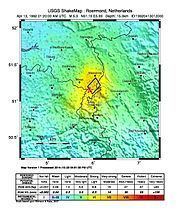Magnitude 5.8 Ml, 5.3 Mw Type Dip-slip Casualties None | Depth 18 km Max. intensity VII (Very strong) Start date April 13, 1992 | |
 | ||
Similar 1992 Nicaragua earthquake, 1992 Cairo earthquake, 1992 Flores earthquake, 1356 Basel earthquake, 1938 Banda Sea earthquake | ||
The 1992 Roermond earthquake occurred on 13 April, around 3:20 AM (1:20 UTC) with a moment magnitude of 5.3 and a maximum Mercalli intensity of VII (Very strong). Striking on the Peel Boundary Fault, a normal fault near Roermond, it was the strongest recorded earthquake in the Netherlands and in Northwestern Europe, and caused substantial damage to older buildings in the Netherlands and adjacent countries of Belgium and Germany. A series of aftershocks followed.
Contents
Tectonic settingEdit
The city of Roermond lies above the Roer Graben, which forms the southeastern part of the Lower Rhine Graben (or Lower Rhine Embayment). These structures form part of the European Cenozoic Rift System, which formed within the foreland of the Alpine orogeny. The Roer graben formed during the Paleogene and is currently active as shown by the thickening of Quaternary sedimentary rocks into the basin. The graben is bounded by NW-SE trending normal fault systems, with the largest fault being the southwest-dipping Peel Boundary Fault, which displaces the base of the Quaternary sequence by about 175 m. All the major faults show evidence of neotectonics.
LocationEdit
The earthquake's focal mechanism showed almost pure normal faulting on a plane dipping southwest at 68°, identified as the Peel Boundary Fault. The epicentre of the earthquake lay kilometers away from the south of Roermond.
IntensityEdit
The earthquake was recorded as 5.8 on the Richter magnitude scale (5.3 on the moment magnitude scale) and a maximum intensity of VII (Very strong) on the Mercalli intensity scale.
An intensity of VII means people have difficulty standing, drivers feel their cars shaking, some furniture breaks and loose bricks fall from buildings. Damage is slight to moderate in well-built buildings; considerable in poorly built buildings. The earthquake was not evenly spread as some areas were hit harder than others. This earthquake could be felt as far away as the Czech Republic, Switzerland, France and England.
DamageEdit
In the regions between Roermond, Maaseik (Belgium), and Heinsberg (Germany), buildings, especially old buildings, and cars were destroyed. Two churches in Roermond, the Munsterkerk and Minderbroederskerk, were heavily damaged. The economic cost of the earthquake was estimated to be around 275 million guilders (around 125 million euros), of which 170 million guilders of damage in the Netherlands.
AftershocksEdit
The earthquake was followed by more than 200 aftershocks.
